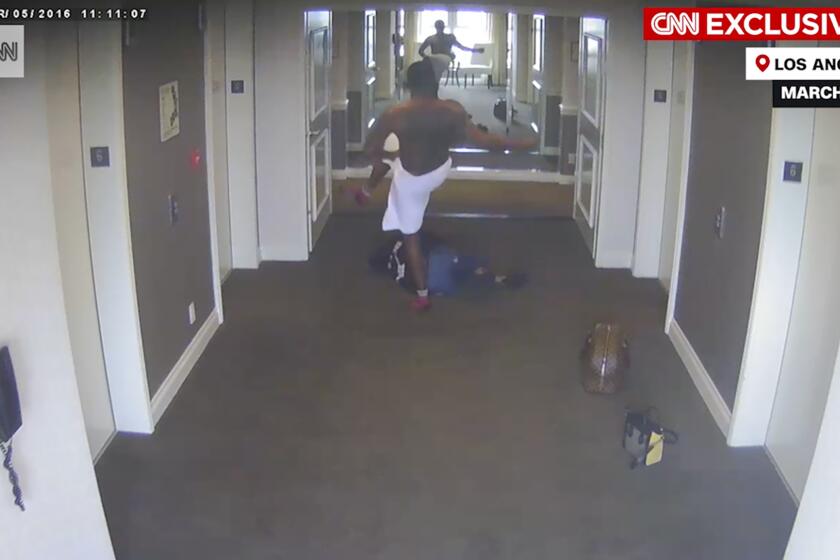Shorty’s in It for the Long Haul : West Coast Jazz Leader, Who’ll Play in O.C., Continues to Keep the Sound Fresh
MARINA DEL REY — In the early ‘50s, a small club on a pier in Hermosa Beach was the center of a musical scene that gave birth to the sound that came to be called West Coast Jazz. The West Coast sound, variously described as cool, sophisticated and soft but also known for its harmonic strength and often eclectic orchestration, was championed by various groups that assembled at the surf-side nightspot from which they took their name, the Lighthouse All Stars.
Of all the musicians who came through the club and helped shape that sound--including composer-saxophonist Jimmy Giuffre, drummer Shelly Manne and baritone sax player Gerry Mulligan--few are as central to its development as composer, arranger and trumpeter Shorty Rogers.
“He’s definitely one of the leaders,” said Pete Jolly, a keyboardist who first met Rogers at the Lighthouse in the early ‘50s, went on to participate in Rogers’ Giants ensemble and is a member of the new All Stars. Conte Candoli, the trumpeter Rogers replaced in the Woody Herman band of 1946 and also a current All Star, concurs. “Shorty is a terrific writer,” Candoli said. “He’s quite capable of doing everything from small-group material to larger pieces for orchestra and movie scores.”
Indeed, Rogers began writing charts for Woody Herman’s band in the late ‘40s, then went to work for Stan Kenton’s Innovations in Modern Music orchestra. He composed music for films including “The Wild One” and “The Man With the Golden Arm,” and made numerous recordings with his own group, the Giants.
The Lighthouse provided Rogers with a convenient proving ground for his music. “I was writing two or three things a day at that time,” the trumpeter said recently from his home in Marina del Rey. “I’d bring them in the same day and sight read them right there on the bandstand.”
So when Bud Shank, Rogers’ friend and former Lighthouse All Star, came to him in 1990 with the idea to regroup the band, it struck a chord.
“I’ve been to Europe I don’t know how many times since 1982,” Rogers, 67, said. “No matter where we go--even some little town in Scandinavia--the evening will not go by without someone coming up to me and saying, ‘Shorty, good to see you. I used to hang out with you guys at the Lighthouse.’ So we came up with this family reunion thing.”
The reunion was captured on disc in the All Stars’ 1991 album, “America the Beautiful.” All but two numbers--the title piece and Bud Powell’s “Un Poco Loco”--were penned by Rogers for the eight-piece ensemble he leads with saxophonist Shank.
Rogers insists, though, that this is no mere exercise in nostalgia. “It’s a reunion, sure,” he said. “But it’s really a new band playing new material. . . . Doing something new is just more fun, it’s part of jazz. Nothing really sits still that long. And it’s the same with music.”
Said Jolly: “The sound has changed. Shorty’s writing for the 1990s now. We’re all playing much differently than we did back in the Lighthouse days.”
Along for the ride with Rogers, Shank, Candoli and Jolly in the current edition of the All Stars are saxophonists Bill Perkins and Bob Cooper, bassist Monty Budwig and drummer Larance Marable.
That lineup, minus Shank, Candoli and Jolly, plus keyboardist Lou Levy, will be on hand as Rogers gives a pair of concerts at the Cafe Lido in Newport Beach on Sunday. The band is being billed as the latest edition of the Giants and, according to Rogers, will play material he wrote for the Giants as well as “Casa de Luz,” his Latin-flavored tribute to the Lighthouse that appears on the All Stars recording.
In addition to “Casa de Luz,” the first All Stars disc pulls together eight of Rogers’ recent compositions as well as his arrangement of “America the Beautiful,” which brings new rhythmic and harmonic twists to the traditional flag-waver.
“Bud (Shank) asked me to look at that tune,” Rogers said. “He’d heard Herb Ellis play it as a bossa nova and said it was just great--the people loved it. So I started fooling around with it and realized it had some nice chord changes. It was very adaptable to what we wanted to do--put it in a jazz context, but not go crazy and make it into something less reverent than it should be. Not to get on a soapbox or anything, but it’s not often you get a piece of music to play that allows you to express some kind of gratitude for this country.”
The same qualities that identified the West Coast sound of the ‘50s can be found on the recent album. While critics often cite Miles Davis’ 1949 “Birth of the Cool” sessions and innovations from Kenton’s orchestra as the immediate inspirations for the school of music that developed in California, Rogers sees deeper roots.
“My own musical heritage goes back to the Count Basie and the Kansas City Seven band, the smaller groups with Sweets Edison or Buck Clayton playing muted trumpet and the great Lester Young on clarinet. The Kansas City Seven is a big ingredient in the West Coast sound,” he said.
“That nice soft sound was used a lot in those days. John Kirby’s band had that kind of sound, a lot of Duke Ellington’s recordings--and especially those groups led by his sidemen--were done in a softer vein. It was just something I grew up with and started to utilize and someone--not me--called it West Coast Jazz.”
It was Rogers’ Lighthouse connection that led to a long career writing and arranging for film and television, employment that eventually drew him away from the club scene. “The Lighthouse became very popular around 1952--(it was) the happening place for jazz in all of L.A. The place was packed every night, and there were marathon sessions--2 p.m. until 2 a.m.--on Sundays. A lot of people in the film community became aware of it and started driving down there.”
Among them was composer Leith Stevens, who soon enlisted Rogers to arrange and orchestrate jazz for a number of films, including “The Wild One” from 1954. Rogers also contributed arrangements for Elmer Bernstein’s soundtrack to “The Man With the Golden Arm,” Otto Preminger’s 1955 film that starred Frank Sinatra as a drug-addicted drummer and poker player. Both scores have been credited with beginning a revival in the use of jazz in film.
Rogers was heavily involved with film and television scoring in the ‘60s and ‘70s. Recently, he finished work on a new film, “The Public Eye” (starring Joe Pesci). It is “a period piece from around 1941 or ‘42,” Rogers said, “that uses quite a few jazz arrangements.” But most of his recent time has been spent touring with the All Stars, including two trips to Europe last summer and appearances at major festivals in the United States.
In addition to “America the Beautiful,” Rogers can be heard on the 3-CD Bluebird reissue “Shortstops: Shorty Rogers With His Orchestra and the Giants,” a collection that encompasses everything from his first three, highly respected RCA albums from the mid ‘50s, as well as four selections from “The Wild One.” San Diego-based Time Is Records has also released a live 1953 big band date recorded in Southern California.
When he’s not involved with music, Rogers spends time on his boat moored in Marina del Rey. The 46-foot, diesel-powered trawler provided the background for the All Stars’ album cover. “That boat is our back yard,” he says. “I can walk over to it in seven minutes or so from here, and we sail to Avalon for as long as we can stay. I’m quite hung up on the ocean.”
Shorty Rogers and the Giants appear Sunday at the Cafe Lido, 501 30th St., Newport Beach, 5 and 8 p.m. Admission: $15. Information: (714) 675-2968 and (714) 673-5056.
More to Read
The biggest entertainment stories
Get our big stories about Hollywood, film, television, music, arts, culture and more right in your inbox as soon as they publish.
You may occasionally receive promotional content from the Los Angeles Times.










